
|
Attracts birds
A deciduous vine-like shrub that grows 20 feet but continues growing as long
as there is something to climb upon. Showy three lobed capsules, yellow orange on the
inside, with crimson seeds; ripens in October. Collected and used for dried
flower arrangements. Plant 18 inches apart. A twining vine
which can easily be grown on fences, against walls, or on the ground. This
plant can be self-pollinizing, but don't count on it. To get berries, plant
at least 5 plants within 30 feet of each other.
Top of page. Habitat homepage |

|
Attracts hummingbirds
and butterflies This is a graceful plant that
grows to a height of 5 to 7 feet. It is a rapid grower
and should be pruned to the ground each March to encourage
new growth. Buddleia davidii is the Black Knight
version; with dark, midnight-blue flowers that appear in
mid-summer. Dead-head faded flowers and it will rebloom
throughout the fall. Plant in full sun, well drained soil.
Top of page. Habitat homepage |

|
Very early bloomer
Crocus (plural: crocuses or croci) is a genus of perennial
flowering plants that grows from a corm, growing naturally from the Aegean
(where crocuses appear in Minoan frescos at Santorini), across Central Asia.
As one of the first flowers to bloom in the spring, the large hybridized
and selected "Dutch crocus" are popular with gardeners. However, in areas
in which snow and frost occasionally occur in the early spring one has
to plant them carefully as it is not uncommon in these regions for the
crocuses to bloom early, only to suddenly wither and die from a
unseasonable "post-winter" frost or snowfall. The spice saffron is
obtained from the stamens of Crocus sativus, a fall-blooming species.
Top of page. Habitat homepage |

|
Traditional 'Easter flower'
Daffodil is the common English name of the botanical
name Narcissus, a showy genus of large-flowered early bulbs.
Most daffodils look yellow, but yellow-and-white,
yellow-and-orange, white-and-orange, pink, and lime-green
cultivars also exist. Daffodils grow perennially from bulbs.
In temperate climates they flower among the earliest blooms
in spring: to this extent daffodils both represent and
herald spring. They often grow in large clusters, covering
lawns and even entire hillsides with yellow.
Top of page. Habitat homepage |

|
Berries food for birds
Grows to 40 feet. Dense lustrous, green foliage, turning scarlet in the fall.
Clusters of white flowers up to 5 inches in diameter bloom in May. Bright red
berries in clusters in the fall. Does best in rich, moist soil,
but is known to grow well in average well drained soil. The white dogwood is
considered to be the best ornamental of all trees. Native to the northeastern
United States. Top of page. Habitat homepage |
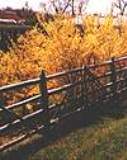
|
Early bloom, fast growth
Very fast, upright growth to 7 feet; spread of 5 feet. One of the best plants
for fast flowering screen. Deep golden flowers early spring. This plant
can easily be pruned after blooming to maintain desired heaith and will
bloom better next year. For hedge, plant 4 feet apart. Top of page. Habitat homepage |

|
The most elegant of all summer blooming bulbs. Perfect for cut flower
arrangements. Hardy in zones 8-10. 'Winter
hardy' hybrids are available for northerly zones. Top of page. Habitat homepage |
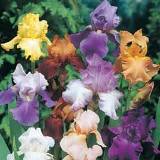
|
Irises can be used as foundation plantings and along walks,
drives and fences. A delightfully brilliant color display
enhanced by attractive sword like foliage. They thrive in every section of
the U.S, and can take extreme heat or cold along with almost any type of soil.
Various hybrids and dwarfs available to match different needs.
Top of page. Habitat homepage |

|
Attracts butterflies and bees
Very aromatic, small bright lavender-blue flower spikes. Semi-evergreen,
aromatic gray foliage retains its sweet fragrance for years when cut. Height
12 to 16 inches and spread 12 to 24 inches. Excellent dried flower, cut flower
or can be used to make a low growing hedge.
Top of page. Habitat homepage |

|
Very fragrant
Old fashioned lilac (Syringa vulgaris) has dense, vigorous
growth to 15 feet. Spread 6 to 10 feet. Masses of light lavender
flowers in late spring. Old flowers should be cut off as soon as flowers fade. An
old fashioned favorite, makes a wonderful flowering screen if spaced 6 feet apart.
Top of page. Habitat homepage |
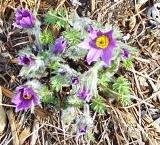
|
Good for naturalizing or border
plant
Also called the Lenten Rose or May Day Flower. A member of the Buttercup family.
Pretty clump of finely divided, hairy leaves followed by silke seeheads in spring.
Grows 6 to 12 inches in height, spreads 6 to 8 inches. A favorite early spring
bloomer, sometimes as early as March. The violet-purple flowers resemble the crocus.
Plant in full sun or partial shade. Likes well drained dryish soil. Hardy, easy to grow.
Pasque flower makes a showy display in a rock garden. Top of page. Habitat homepage |
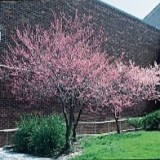
|
Very effective as mass planting
Height 20 to 30 feet. Spread 25 to 35 feet. Flowers are perfect, reddish-purple in
bud, opening to a rosy-pink with purplish tinge in early spring. Large, dark green,
heart shaped leaves 3 to 5 inches long and wide.
Top of page. Habitat homepage |
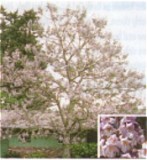
|
Paulownia tomentosa, also called Empress Tree. an extremely fast growing tree.
Height and spread 30 to 40 feet. Large leaves, up to 2 feet across. Clusters
of trumpet-shaped flowers, pale violet with darker spots and yellow stripes inside, spring.
Relatively new tree for American tree farmers. Top of page. Habitat homepage |

|
Fruits quite attractive to birds.
Amelanchier candadensis. Also know as Juneberry. height 25 to 30 feet. One of the
first native trees to bloom in early spring. Serviceberries are covered with billowy
masses of small white flowers in racemes. Berry-like edible fruits in summer, are
maroon-red. Fall color is yellow to
red. Fast growing. Top of page. Habitat homepage |

|
Tulip (Tulipa) is a genus of about 100 species of flowering plants in the family
Liliaceae. They are native to southern Europe, north Africa, and Asia from Anatolia
and Iran (where the flower is suggested on the nation's flag) east to northeast
China and Japan. The centre of diversity of the genus is in the Pamir and Hindu
Kush mountains and the steppes of Kazakhstan. They are perennial bulbous plants
growing to 10-70 cm tall, with a small number of strap-shaped, waxy-textured,
usually glaucous green leaves and large flowers with six tepals.
Top of page. Habitat homepage |
 Habitat homepage
Habitat homepage